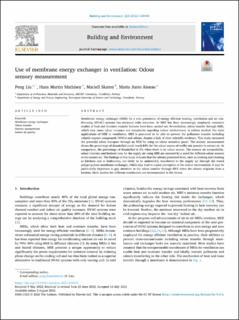| dc.contributor.author | Liu, Peng | |
| dc.contributor.author | Mathisen, Hans Martin | |
| dc.contributor.author | Skaten, Mariell | |
| dc.contributor.author | Justo Alonso, Maria | |
| dc.date.accessioned | 2022-08-11T06:12:45Z | |
| dc.date.available | 2022-08-11T06:12:45Z | |
| dc.date.created | 2022-08-02T09:22:03Z | |
| dc.date.issued | 2022 | |
| dc.identifier.issn | 0360-1323 | |
| dc.identifier.uri | https://hdl.handle.net/11250/3011184 | |
| dc.description.abstract | Membrane energy exchanger (MEE) for a new generation of energy efficient heating, ventilation and air conditioning (HVAC) systems has attracted wide attention. As MEE has been increasingly employed, extensive studies of heat and moisture transfer features have been carried out. Nevertheless, odour transfer through MEE, which may cause odour nuisance and complaints regarding indoor environment, is seldom studied. For most applications of MEE in ventilation, MEE is presumed to be able to prevent the pollutants transfer including volatile organic compounds (VOCs) and odours, despite a lack of clear scientific evidence. This study measured the potential odour transport through an MEE by using an odour sensation panel. The sensory measurement shows the percentage of dissatisfied could reach 84% for the odour source of waffle mix powder in extract air. In comparison, the percentage of dissatisfied is 5% when there is no odour source. The sensory air acceptability, odour intensity and hedonic tone for the supply air using MEE are assessed by a panel for different odour sources in the extract air. The findings of this study indicate that the odours generated from, such as cooking and cleaning in kitchens and in bathrooms, are likely to be undesirably transferred to the supply air through the tested polypropylene membrane exchanger, which may lead to a poor perception of the indoor environment. It may be particularly important to pay attention to the odour transfer through MEE when the odours originate from a kitchen. More studies for different membranes are recommended in the future. | en_US |
| dc.language.iso | eng | en_US |
| dc.publisher | Elsevier | en_US |
| dc.rights | CC BY 4.0 | * |
| dc.rights.uri | http://creativecommons.org/licenses/by/4.0/ | * |
| dc.subject | Membrane energy exchanger | en_US |
| dc.subject | Odour transfer | en_US |
| dc.subject | Sensory measurement | en_US |
| dc.subject | Indoor air quality | en_US |
| dc.title | Use of Membrane Energy Exchanger in Ventilation: Odour Sensory Measurement | en_US |
| dc.title.alternative | Use of Membrane Energy Exchanger in Ventilation: Odour Sensory Measurement | en_US |
| dc.type | Peer reviewed | en_US |
| dc.type | Journal article | en_US |
| dc.description.version | publishedVersion | en_US |
| dc.rights.holder | © 2022 The authors | en_US |
| dc.subject.nsi | VDP::Teknologi: 500 | en_US |
| dc.source.pagenumber | 10 | en_US |
| dc.source.volume | 222 | en_US |
| dc.source.journal | Building and Environment | en_US |
| dc.identifier.doi | 10.1016/j.buildenv.2022.109430 | |
| dc.identifier.cristin | 2040541 | |
| dc.relation.project | Norges forskningsråd: 296489 | en_US |
| dc.source.articlenumber | 109430 | en_US |
| cristin.ispublished | true | |
| cristin.fulltext | original | |
| cristin.qualitycode | 2 | |

